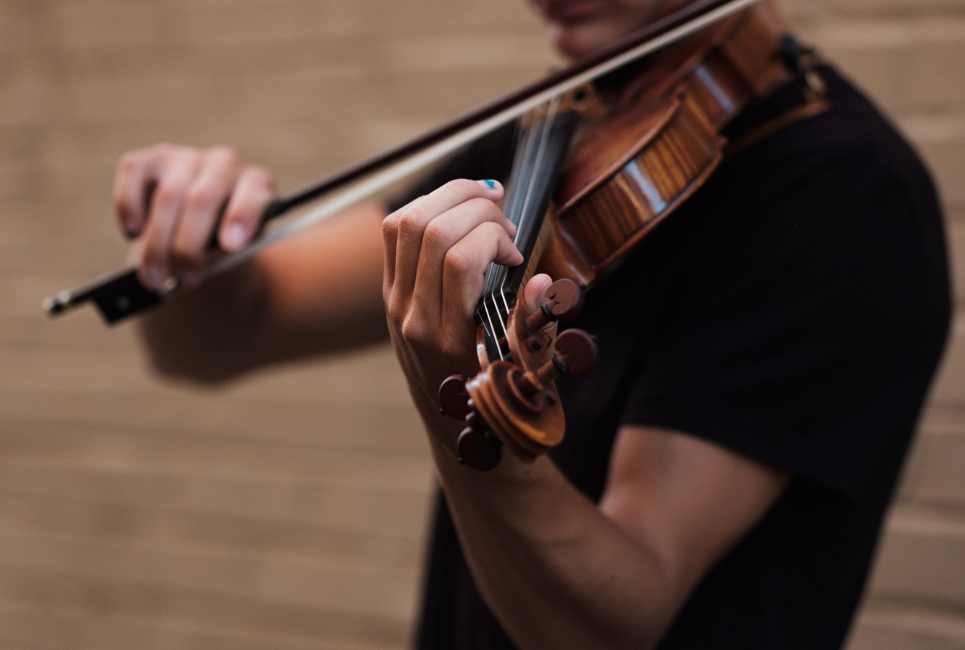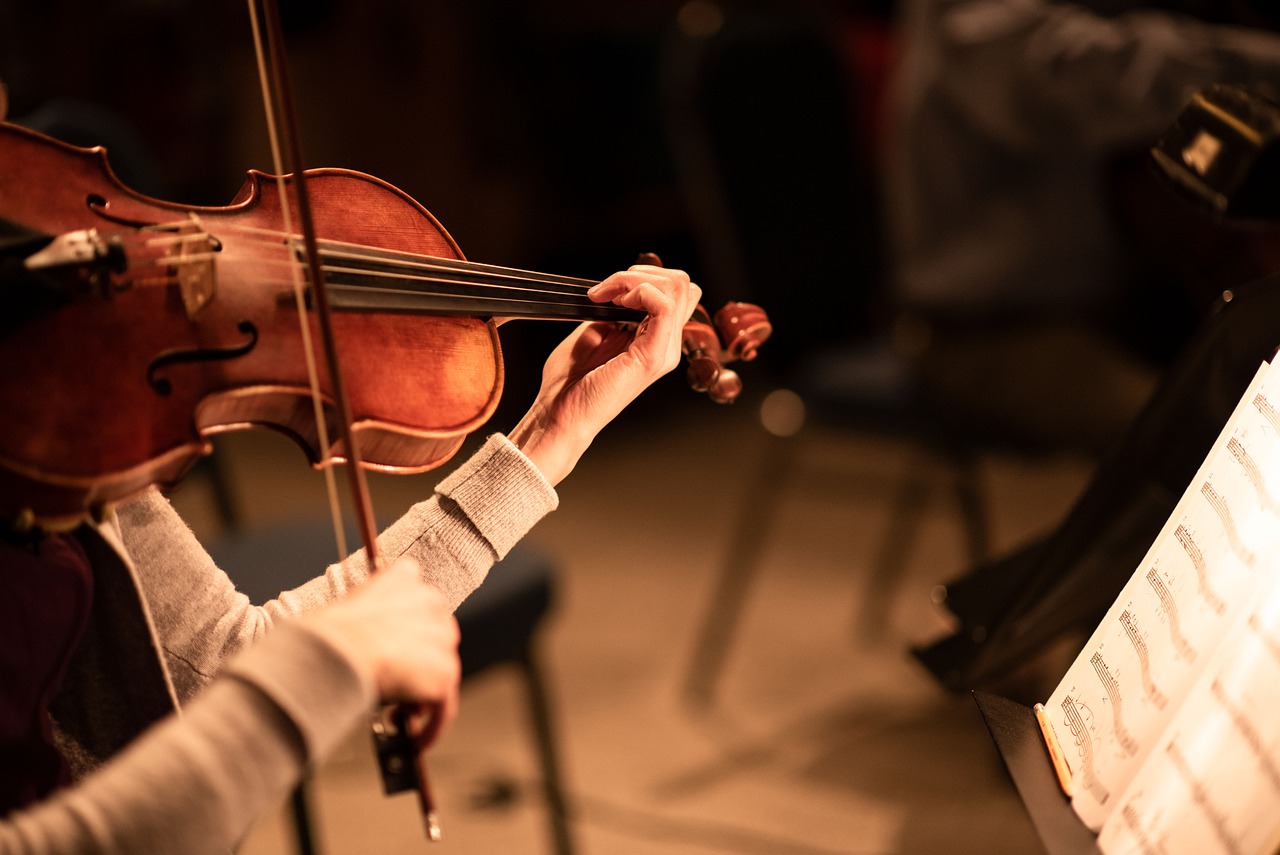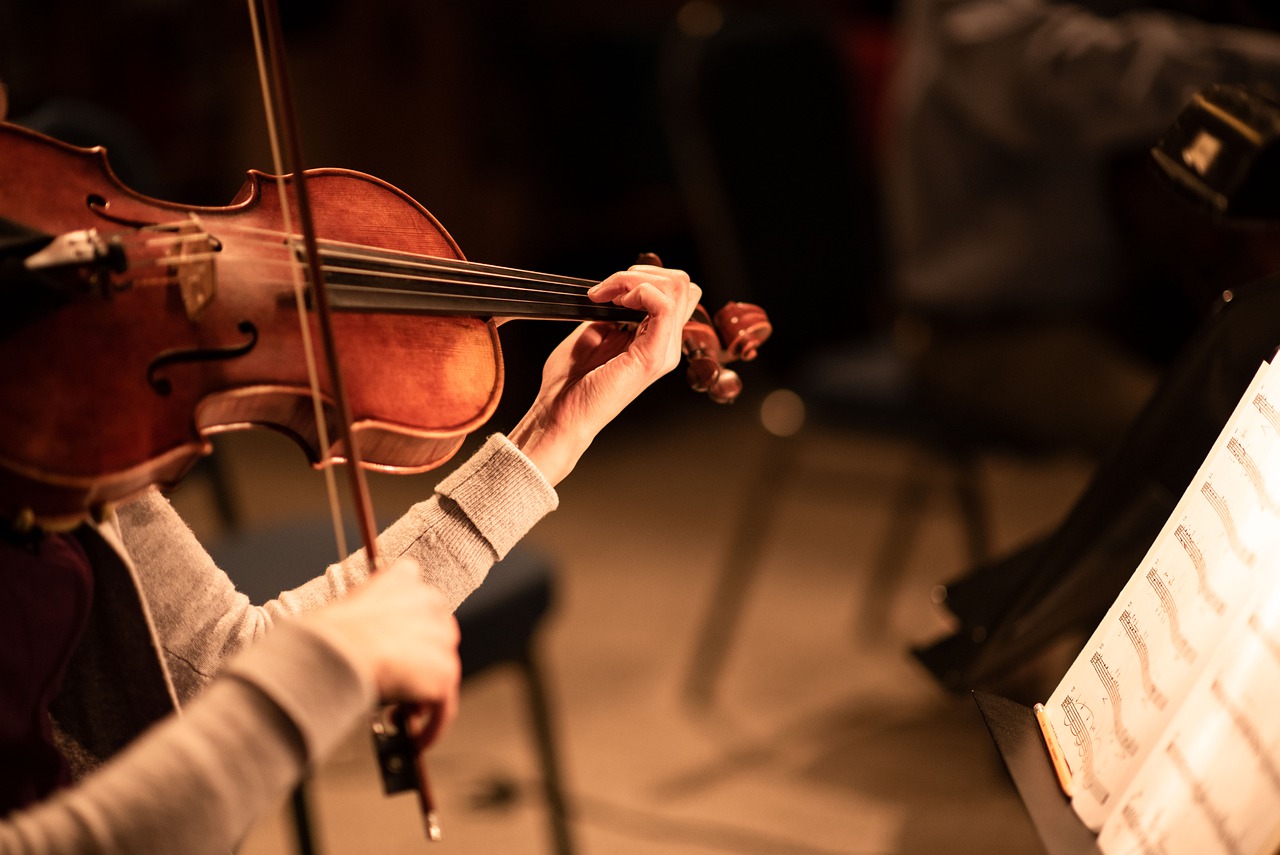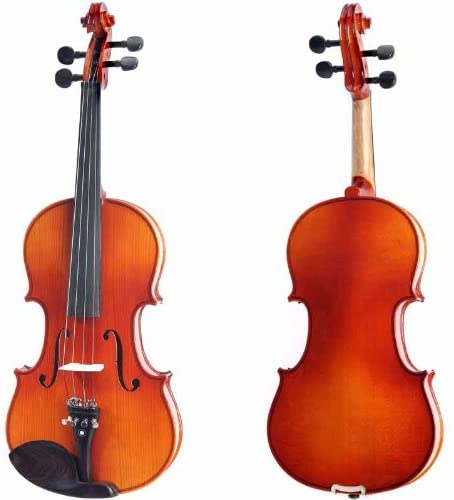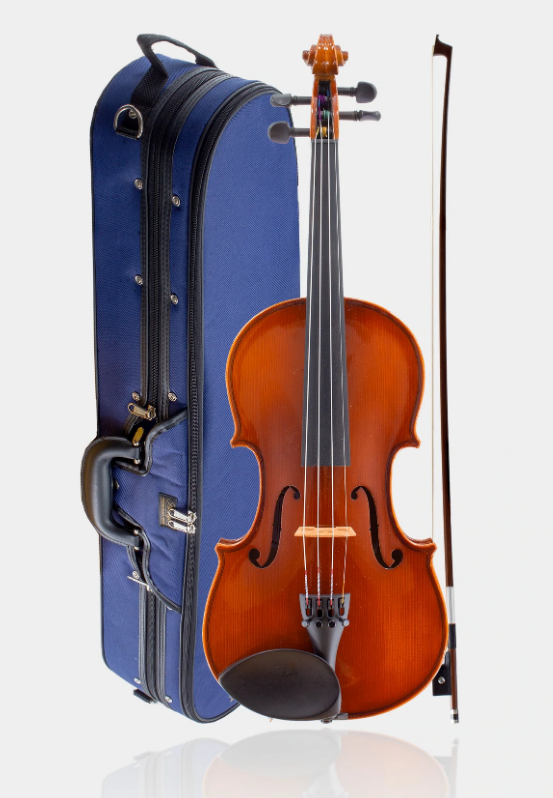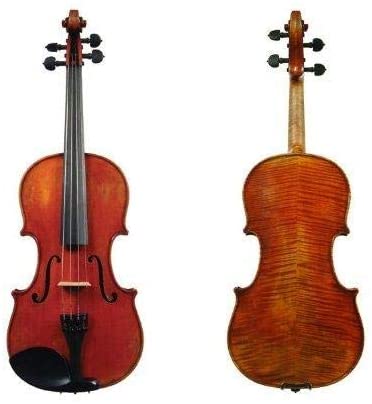- Best Violin Stand Options Guide - May 26, 2022
- Best White Violin Options - May 22, 2022
- How to Find the Best 7/8 Violin - May 19, 2022
Purchasing a violin can be a difficult process, especially if you don’t know what size to buy, and I’m hoping that the following best 4/4 violins guide will help make things easier. I was there once years ago trying out all sorts of different violin sizes, and it was an absolute minefield.
I will always remember the moment when I first decided to pursue learning the violin – I had seen a few performances at a local concert hall as well as on TV, and I was simply mesmerized by the instrument. There was just something about the way that the notes resonates, the elegance of the performance style, and the compositions that were made on it. It blew my mind.
However, the magic was quickly diminished when I got down to the dirty details – did I need a 4/4 violin or a smaller size? Which brands made the best 4/4 violins? Should it come with accessories or should I buy them separately? I had so many questions, and the whole situation was overwhelming.
Don’t worry though, because I’m here to help. Whether you’re a beginner violinist looking to purchase their first 4/4 violin or you are an expert looking for some professional recommendations, I’ve included plenty of information here for everyone. Read on to find out more!
Bottom Line Up Front: The Cecilio 4/4 CVN-300 is a fantastic 4/4 violin option if you are a beginner on a budget, providing excellent value for money and coming bundled with everything you need to get started as a violinist. However, if you’re looking for an upgrade, saving up for the luxurious yet pricey D Z Strad Model 365 will be well worth waiting for.
Is 4/4 the Right Size Violin for You?
Before we get started on investigating the details behind the best 4/4 violins and what you should look for in them, let’s take a moment to consider a basic necessity – is 4/4 even the right violin size for you? This is a very important question to ask yourself, as unfortunately, there is a lot of stigma and expectations for professional violinists to use 4/4 violins, even when it is not necessary.
The reason for this is that 4/4 violins are considered to be ‘full-sized’, the standard instrument size that will be found in the hands of adult performers at orchestras. Whilst this is true and 4/4 violins are most common, you should ignore the implications of ‘full-sized’. The only important thing is for you to be comfortable with the instrument, and if that means a smaller size, then so be it!
Perhaps the most obvious alternative to a 4/4 violin is the 7/8 violin. Most people associate smaller instrument sizes with children, assuming that the only reason someone would use a small instrument is that they are not fully grown. However, this could not be further from the truth – people come in all sorts of shapes and sizes, and people with smaller hands, heights, or frames may benefit greatly from using a 7/8 violin. The size difference is almost unnoticeable to the human eye, yet it feels so much better when you need it.
The reason I am saying all this is simple – if you force yourself to play a 4/4 violin when you need a smaller size, you could put yourself off learning the instrument altogether. I had a friend in school that this happened too – she was barely five feet tall and admitted defeat, claiming that she’d never be big enough to play the violin. I just wish that I could go back in time and tell her that she needed a 7/8 instrument!
Choosing the Right 4/4 Violin
Now that we’ve made sure that 4/4 is certainly the size of a violin that you should be looking for, let’s move on to some of the more juicy details. We will later be discussing three of my top 4/4 violin recommendations, but for now, let’s take a look at exactly what I look for when choosing an excellent 4/4 violin.
Comfort
I hate to sound like a broken record, but I’m going to quickly cover some more information about violin sizes. It doesn’t matter how beautiful a 4/4 violin that you find is, if you cannot play the instrument comfortably, what’s the point in purchasing it? You’ll never want to practice at that rate!
We’ve already established that you should consider 7/8 violins if you are a smaller person, but let’s assume that you are happy with a 4/4 instrument. Firstly, you should be able to stand up and hold the violin comfortably, resting it against the chin rest with no imbalance or friction. The posture of holding a violin will be uncomfortable if you have never played the instrument before, but it should at least be imaginable that the posture will become comfortable.
Next, you will need to ensure that you can navigate the fingerboard smoothly with your left hand. It may be comfortable to hold a violin, but if the fingerboard is too large or the material doesn’t feel right, certain sections of the fingerboard may become an obstacle and no one needs that!
The weight is also something important to consider – violins are pretty light instruments so hopefully, this shouldn’t be too much of a proper, but some are heavier than others, and this weight can make a difference. You will want to ensure that you can endure holding and performing with the violin for a long period because you will be expected to during lengthy concerts!
Overall, all of these pointers can be considered through a simple visit to a music store. Turn up somewhere that sells violins, ask for some assistance from a customer assistant, and they will be able to walk you through a checklist of comforts to ensure that a violin size and body works for you. Trust me, you may feel a little silly asking for help at the time, but it will all be worth it when you go home knowing that your new violin is 100% comfortable.
Brand
Right, I promise that we are done talking about violin size and comfort now. It’s now time to take a look at some of the more exciting parts of choosing a violin, such as choosing a brand. Firstly, brand is not everything when it comes to choosing a 4/4 violin. Some violin brands have excellent reputations for producing high-quality instruments, but these might be a bit unnecessary for a beginner.
In my opinion, it is better to think about brands to avoid rather than brands that stand out. The reason for this is there are a ton of excellent 4/4 violin brands, within both low and high price ranges, and choosing one ultimately comes down to your budget and experience level. However, there are several violin brands out there that I would actively recommend that you avoid. The reasons for this range from having consistently bad reviews, using cheap and poorly manufactured materials, not including accessories (see more on this later), or simply providing terrible customer service.
There is one simple way to avoid coming across a brand like this – read the reviews! I cannot emphasize this enough, reviews are fantastic resources for tapping into the opinions of recent purchasers of a product. If a brand is good, this will be well reflected in its online reviews, and vice versa if they are bad.
Always do your research, and never blindly purchase a 4/4 violin from a brand without meticulously investigating them. There’s no need to go for a luxuriously expensive brand if you are a beginner – just make sure that they look after their violins and their customers!
Cost vs Quality
We briefly covered this when discussing the brand of 4/4 violin to choose, but the ratio between cost and quality is so important that I think it deserves its own section. Firstly, let’s get something clear – it is undeniable that violins are going to be of a generally higher quality when they are expensive. This is just how the world works – expensive TVs are better, expensive houses are bigger, and expensive violins are generally of a higher quality.
However, just because something is of high quality does not mean that you will be any better at playing on it. It will not affect the way that you learn the instrument – it will simply look and sound better. You wouldn’t believe the number of times that I had heard awful scratchy violin playing from a distance, turning the corner to see a young, rich student playing a $5,000 violin!
In contrast, I will always remember one student that I taught a few years ago who is perhaps the best young violist I have ever heard, and guess what violin they were using? I couldn’t even tell you, it was brandless and probably cost her $50 to $100, but my goodness did she perform well with it!
What I am trying to explain can ultimately be summarized through the phrase “it’s not the tools that you’ve got, but the way that you use them”. Sure, an expensive violin with premium tonewoods and ebony fittings is going to look and sound marvelous, but do you need that to learn the instrument? It goes without saying that expensive 4/4 violins are fantastic for upgrading from a beginner model, and if you have money to burn then why not spend it.
However, I would ultimately say that if you are on a budget like most musicians, try to find a balance between quality and cost. I’m not saying buy the cheapest violin you could find – this will likely have bad reviews, reflective of poor build quality and brand reputation. However, I’m saying find somewhere in the middle. There’s no need to take out a mortgage for your 4/4 violin – simply save up enough money for a decent beginner’s model, and you’ll be good to go.
Bundled Accessories
The last key point that I wanted to mention when considering the best 4/4 violins is the accessories that come bundled with them. If you are an intermediate or expert violinist, you can probably skim read or even skip this section, as you are likely to already own all the accessories you could ever need. However, if you are a beginner to the instrument looking to get kitted out, this section will be very important!
Much like many other hobbies, learning the violin doesn’t exactly begin when you take the instrument out of the box. For starters, you’ll need a bow, and some strings on the instrument to use the bow with. You probably won’t have to worry about this too much, as the majority of 4/4 violins will come as an “outfit”, meaning that it includes strings and a bow. However, many violins also come with additional accessories.
Some of the most common include violin rosin which you will need to keep your strings resonant, a violin case for traveling, and a chinrest. However, the list doesn’t end here – you are also going to need a tuner to ensure your violin is tuned correctly, a violin stand to store it somewhere safe in your home, violin music books, spare strings… the list goes on!
It’s relatively difficult to find a violin bundle that includes all of these accessories, but believe it or not, some of them do. If you are a complete beginner, I would highly recommend that you investigate 4/4 violins that include as many accessories as possible. There is no worse feeling than when your first violin arrives, only to discover that you can’t even play it because the strings are out of tune or need rosin application. Purchase your violin in a bundle on the other hand, and you will be able to start your violin adventure straight out of the box!
My Top 3 Recommendations for the Best 4/4 Violin
We sure have covered a lot of information in a short space of time – from understanding when 4/4 is an appropriately sized violin to recognizing the positive and negative traits in 4/4 violins, you should now have a much clearer concept of what to look for. So, without further ado, I think it’s about time to cover my top three recommendations for the best 4/4 violins. I’ve made sure to choose one within each of the three major price ranges beginner, intermediate, and professional, so don’t panic because there is bound to be a violin here for you.
Cecilio 4/4 CVN-300
When it comes to recommending the best 4/4 violin, I simply couldn’t write a product list without including something from Cecilio. I’ve always spoken very highly of Cecilio for both violins and cellos, and this time it’s going to be the Cecilio 4/4 CVN-300.
This is very much a beginner’s violin and is priced accordingly, but I think the quality of it is incredibly high all things considering. It’s got a solid spruce wood top, with maple back, neck, and sides which are relatively expected. However, what many do not expect considering the price of this violin is that it has an ebony fingerboard, pegs, and chin rest! This is the kind of feature that you generally only find on far more expensive violins, so it’s pretty impressive.
To make things even more impressive, Cecilio has even included two Brazilian wooden bows within the outfit with Mongolian horsehair, a lightweight hard case, rosin cake, and an extra set of violin strings. Seriously, this outfit is amazing value – I just wish something like this had been around back when I first started playing the violin!
Pros
- Created by Cecilio, a brand well known for producing high-quality entry-level 4/4 violins
- Includes ebony fittings, which is very unusual for the price
- Comes as an outfit with not one, but two Brazilian wooden bows with Mongolian horsehair
- Bundled with rosin, a hard case, and spare strings
Cons
- Built-in bulk at a factory, not handcrafted by a luthier
- Despite the excellent value, it won’t sound too impressive in comparison to more expensive models
Stringers Superior
The next 4/4 violin on my list is the Stringers Superior – this is a violin brand that not too many of my musician friends knew about until recently, and boy do they know about it now – I can’t shut up about them! I think they’re a real hidden gem in the world of violins, and this Superior violin is a prime example.
I first used this violin on a recent orchestra trip to Edinburgh, and I was instantly blown away by the resonance, especially considering its price. Each violin is made unique and set up manually, and comes fitted with high-quality ebony fittings and Pirastro Tonica strings – fancy!
It only came with a bow when I rented mine, so I assume this is all that is included in the purchase bundle. That may seem a bit stingy considering the intermediate price range, but trust me – you just need to hear this violin and you’ll change your mind.
Pros
- A truly stunning tone
- Excellent amplification
- Fitted with gorgeous Pirastro Tonica strings
- High-quality ebony fittings
Cons
- Doesn’t come with bundled accessories other than a bow
- Although each violin is set up manually, they are still not handcrafted
D Z Strad Model 365
The final best 4/4 violin that I feel deserves a mention is the D Z Strad Model 365. If you’ve read any of my other articles, you’ll be aware that I am a huge fan of D Z Strad violins and cellos. They’re pretty pricey so I’ve only ever bought one, and that is the Model 365.
It will cost you well over $1,500 brand new, but this is because the violin is 100% handmade, 100% manually set up, and 100% hand-varnished. You can notice this attention to detail when performing with it – the tone is super warm and round, it feels incredibly comfortable to hold, and the consistency of the intonation is second to none.
Along with ebony fittings, and a wood grain that is to die for, this violin even comes bundled with Dominant strings, a case, a bow, rosin, and shoulder rest. That’s pretty rare considering it’s a professional violin! It’s a stunning violin overall and whilst it costs a pretty penny, it’s worth it.
Pros
- Handcrafted by professional luthiers
- Set up and varnished by hand
- Stunning ebony fittings
- Bundled with a case, Dominant strings, a bow, rosin, and a shoulder rest
- Extremely comfortable to hold
Cons
- A very expensive option that is generally only recommended for professional violinists
FAQ
Finishing things up with the D Z Strad, I couldn’t think of a better way to close this guide to the best 4/4 violins! However, before I leave you to do some online shopping, I’m going to round things off with a quick FAQ – hopefully, they answer any final burning questions that you may have!
Answer: Whilst 4/4 is certainly the most common adult violin size due to it being full-sized, it won’t fit every adult, with many smaller people preferring 7/8 or even ¾ options.
Answer: All excellent 4/4 violins should be comfortable to navigate and hold, should be bought from a brand with excellent reviews, should at least come bundled with a bow, and should have a decent cost to quality ratio.
Answer: Absolutely – Cecilio has an excellent reputation for producing high-quality 4/4 violin brands for beginners on a budget.
Final Thoughts
Well, that brings us to the end of this guide to the best 4/4 violins! I hope that you enjoyed reading this as much as I enjoyed writing it and that you will be walking away with a solid idea of what to look for when you purchase your first (or next) violin.
In my opinion, you simply cannot beat the Cecilio 4/4 CVN-300 for a beginner, the value to price ratio is just next level! However, if you are made of money and are confident that you will be sticking out the violin for the long run, the D Z Strad Model 365 may be more what you are looking for.
I wish you all the best on your violin journey and feel free to print off this guide when you head to your local violin shop for assistance. Good luck!
Looking for more interesting readings? Check out:

